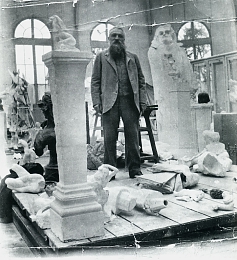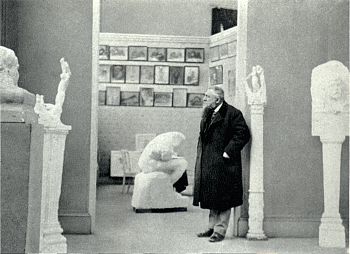H. de Roos - Rodin´s Approach to Art |
|||
16. accident and damage For Rodin, a single hand, a torso, an unfinished study could contain as much truth and beauty as the complete figure. One reason Rodin appreciated such partial works may have been that most relicts of antique sculpture had not survived the ages in one piece. He was impressed these battered works still possessed their charm, not because they were old, rare and expensive, but because in his eyes, the harmony and vigour with which they had been created still was present in every detail. In his conversations with Bartlett, Dujardin-Beaumetz and others, Rodin used to tell that during the cold winter of 1863/64 he hat not been able to heat his atelier in Brussels overnight, so that his terracotta model for The Man with Broken Nose froze and bust; he then would have decided to exhibit the remaining part as a mask instead of trying to restore the complete head. The anecdote should show Rodin was prepared to accept chance and accident to co-determine the appearance of his works. Another anecdote, mentioned by John Tancock, seems to support this as well:
When Rodin and Paul Gsell saw a cast of the Thinker (..) which was destined for America left out on the open air, Rodin remarked: "The rain water brings out the parts in relief by oxydizing them, while the dust and dirt, lodging in the hollows, accentuate the depth... It is not only due to the familiarities of the birds that bronzes and marbles left in the open air gain their rich
patinas." Other Rodin scholars have pointed out, though, that Rodin´s account on the mask of The Man with the Broken Nose very well may have been a romanticising fiction, to justify his own artistic decision with an intervention of fate itself. According to J. A. Schmoll, cropping the portrait to a mask would have intensified the expression of the face. Moreover, the form of a mask would have been easier and cheaper in casting.
|
|||
Better documented than the nascency of Bibi´s mask are those occasions on which Rodin himself wilfully damaged plasters because he was not satisfied with their form, or as a method of editing them. In the Maryhill Collection, Washington, a thus mutilated plaster version of The Thinker is on display. The story tells us, Rodin did not like its appearance, and broke off the right foot. A second example: In his Pavilion at Place d´Alma, Paris, during the 1900 World Exposition, Rodin exhibited a Thinker plaster without the head, left arm and right leg, now in the collection of the Musée Rodin. On other occasions, Rodin would break off parts of complete plaster casts to present them as artworks for themselves or use them as material for new assemblages. |
Rodin and headless Thinker, Place d´Alma,
1900
|
||
|
Malvina Hoffmann recounts: He would hand me little plaster figures and ask me to cut off the arms and the legs; then with white wax, he would rearrange the groups, changing a gesture and adding action or some new suggestion of composition. Ambroise Vollard even reports of a wild "slaughter", in which Rodin chopped off the head and limbs of a series of enlargements with a big sword. To his shocked guests, he explained that during the enlargement process, the right proportions of the subject had gone astray; the single parts, however, were of perfect shape.
|
|||
|
|
|
|
Notice:
Museum logos appear only as buttons linking to Museum Websites and do not
imply any |
|

